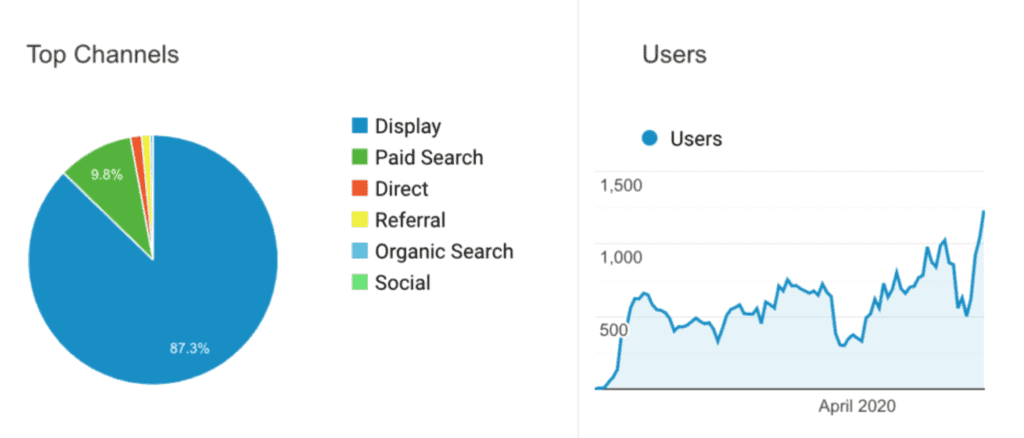Dive Deep:
The Secret to Launching a Successful Website


By now, you’ve probably gone through the process of launching a website or two, either for your own organization or for an employer. The average lifespan of a website is between three to five years, and we’re well into this thing called the digital revolution, so I’m willing to bet you have at least some peripheral experience with this.
It’s also likely those experiences left you feeling less than enthusiastic about the thought of upgrading your site or launching a new one. The expense alone can be enough to make you consider trying to squeeze another year out of what you’ve got, but we all get to the point where we know—deep down—that it’s time. Something about that Comic Sans font just isn’t doing it for you anymore.
What are your next steps?
For most people, they Google the competition and start drawing comparisons. The checklist looks a bit like this:
No doubt, all of those things look great, and you should be aware of what your competition is doing. But is their site actually working for them? How do you know? Should you just copy what they did and call it a day? SquareSpace does have some really generic nice-looking templates.

But the truth is...
Are you scratching your head yet?
Sure, you can go through the motions of implementing the latest and greatest technology, having a blazing-fast site, a sexy design, maybe sprinkle in some testimonials, and even hire a bad-ass photographer to really capture the essence of your organization. But, having personally led the development of hundreds of websites over the years, from .coms to .govs and everything in between, I can say with confidence that the most successful sites always have one thing in common:
A hyper-clear vision of who they are and who they serve.
That sounds simple enough on the surface, but nothing brings to light just how much your organization has lost sight of its original goals (or never had them to begin with) like the process of redesigning a website.
That apprehension I mentioned earlier about a new site isn’t actually rooted in the financials. It comes from the fear of not having a clear vision and a lack of purpose. If you’ve found yourself asking, “What do we put on this thing?” then that’s a big red flag. Your website, after all, is just a digital representation of your business and its processes. When you have a clear vision of who you are and who you serve, then you already have your answer. You’ll also better understand that investing in your site is the same as investing in any other part of your business that makes you money, and the whole website redesign thing suddenly doesn’t seem so daunting, especially with the right team behind you.
But how do you get the kind of clarity that leads to a successful website?
Again with the obvious, but it’s surprising just how little this happens. When was the last time you actually spoke with your customers about their experiences with your organization? Sure, you can send surveys and read online reviews, but nothing beats a face-to-face conversation (or a Zoom call during a global pandemic) to learn more about who you’re serving and how their needs have changed.
Part of our 360 Process is to sit down with our clients’ customers and record/transcribe our conversations with them (with permission, of course). We bring conversational questions designed to learn all about where you’re excelling and uncover hidden opportunities to fill a need you didn’t realize your customers had. Not to sound too click-baity, but the results might surprise you.

How does this translate to your website?
By uncovering what really drives your customers, we remove the guesswork about what actually drives sales. Through those face-to-face conversations, we better understand the kind of language to use when communicating with your customers (often using the exact same words they use when describing their experiences). Content is king, after all. Without the right words, that slick-looking website isn’t going to help you.
This strategic approach positions your site (and your brand) as authentic and human, which can feel particularly refreshing in our current online environment of algorithms and bots.
Coming out of our previous step, where we spoke directly with customers to learn more about their take on your business, the next area to get clear on is your offerings. This can be tricky because you’ve probably been offering the same products and services for a long time, so it’s tempting to skip this part and assume you’ve got it on lockdown, or that simple adjustments to pricing will be enough.
The world is changing, and your offerings and processes need to adapt. This is true with or without crazy years like 2020. You aren’t the same person you were a few years ago, and neither are your customers.
I’m not going to sugarcoat it: this isn’t an easy process, and doing it right can sometimes feel wrong. That’s why introducing a new perspective (like the one Wallace360 brings to the table, *ahem*) can be a reliable way to get beyond your own biases and assumptions. But you can still ask yourself these questions:
Are your offerings meeting your customers’ needs? Do they bring you closer to your own business and personal goals? Checking this against the 80/20 rule can be a great place to start.
How does this help your website?
By getting clear on your offerings and actually offering things that people want, your website becomes significantly more targeted. Not only will more specific product offerings result in higher organic search traffic, by way of better Search Engine Optimization (SEO), but that traffic will be more likely to convert to the kind of sales that actually benefit your business.
Pro tip: Don’t lump all of your product offerings on one page and call it a day. Break each one out into its own page, and be specific about who it’s for and which problems it solves. This trick alone will give you huge bump in your SEO.
Bear with me because this might get a bit… dry. But you don’t want to overlook the data, and I’d be doing you a disservice by skipping over it. If this just isn’t your cup of tea, skip down to the next section. You’re going to need it.
By now, you’ve probably at least heard of the free tracking tool, Google Analytics. It’s a magical tool that lets you track and measure your digital marketing efforts in granular detail. If this isn’t already on your website, you should get that taken care of ASAP. There are alternatives available, but for the sake of this article and getting you some quick data, let’s stick to Google Analytics.
Not sure if your site is running Google Analytics? Send us message and we’ll let you know.
Now, what to do with all this data? It’s not very useful if you don’t know what you’re looking at, but even non-techy folks can find some valuable bits of information here pretty quickly and easily. I recommend starting with the Acquisition Overview section and the Behavior Overview section.

Just from these two quick overviews, we can learn a lot. We can see how much visibility and traffic your current site is getting, where that traffic is coming from, and what information visitors are most interested in. The longer you track user activity, the better picture you’re going to get.
When we work with our clients to examine their data, we go as far back as we can to identify patterns and external events that resulted in unexpected traffic spikes. Along with measuring numerous other metrics, we also confirm information that we discovered during the previous two steps, where we engaged with real people and made impactful decisions about how best to serve them with your offerings.
Google Analytics is easily the quickest and easiest way to get informative data, but I’d be remiss if I didn’t mention a few other tools we like to use. When needed, your website might benefit from at least one of the following:
How does all of this inform a better website?
With a clear, data-driven understanding of who your online customers are, where they’re coming from, and how they find and engage with your organization online, you get a clear picture of where to focus your efforts. Whether that’s shifting more budget to social media marketing, adding or removing specific pages from your site, ad retargeting, or all of the above, any decision made will be done with clear intent and reasoning.
A word of caution, though: Data can easily seem like the be-all, end-all decision maker that’s infallible in its guidance. But data can be tricky, and it can be deceptive. Its real strength is found in its ability to connect the dots between our earlier findings. Avoid vanity numbers like “Impressions” and be on the lookout for high traffic or engagements that don’t seem to be doing anything. These feel great, but they’ll steer you in the wrong direction if you’re not careful. Which brings me to my final point.
There’s one more thing successful websites all have in common: They got it done and launched.
This is obviously everyone’s goal, but website projects fall apart all the time before they ever go live. Whether they never got off the ground to begin with, got caught up in boardroom-review hell, or ran out of money, it usually comes back to the same core problem:
Not having a hyper-clear vision of who you are and who you serve.
Our clients avoid these pitfalls by working with us to align the whole organization from the get-go and helping them adapt to their current situation. The unbiased, third-party perspective and experiences we bring to the table are often key to pushing past the inner roadblocks that every organization has, so when it’s time for that new website, moving forward efficiently becomes easier and everyone involved knows what it’s going to accomplish.
The site gets launched—which is ultimately the most important thing.
The beauty of the Web is that nothing is set in stone. Your website should continue to evolve with your goals and customers in mind. By getting strategic about your business as a whole before diving into your redesign, you’ll be positioning your organization—and your website—to adapt to the ever-changing landscape and ensure that your investment continues to pay you dividends, no matter what the future holds.
